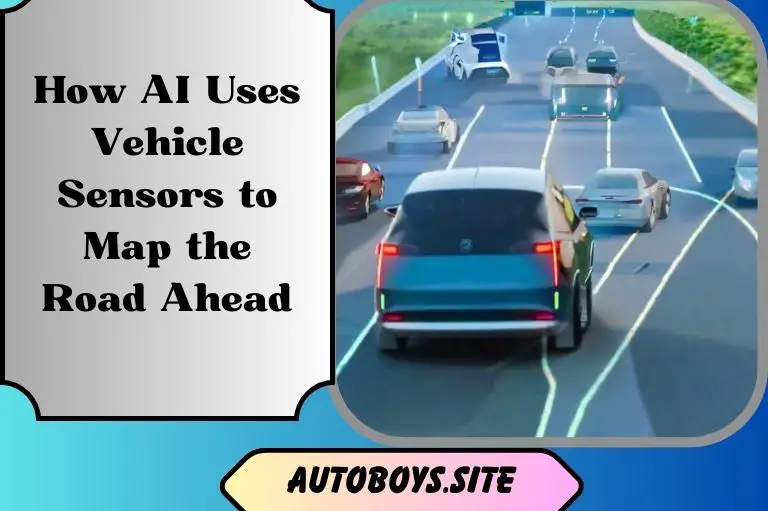Sensing the Future: How AI Uses Vehicle Sensors to Map the Road Ahead
The road to autonomous vehicles is paved with data. Self-driving cars don’t just operate based on pre-programmed routes and schedules – they must dynamically sense and map their surrounding environment to navigate safely. Artificial intelligence and machine learning technologies are enabling autonomous vehicles to perceive the world through onboard sensors like cameras, radar, and LiDAR and make real-time driving decisions accordingly.
As vehicles become more automated, AI and ML will play an increasingly critical role in how they operate and interact with the world around them. By detecting and classifying objects, assessing distances, and anticipating the behavior of other vehicles and pedestrians, AI helps ensure self-driving cars have a robust understanding of road conditions and potential hazards. While fully autonomous vehicles are still on the horizon, continued progress in AI and sensor technologies is helping to map the way to a driverless future.
The Role of AI and Machine Learning in Autonomous Vehicles
Artificial intelligence and machine learning are enabling autonomous vehicles to sense and map the world around them. AI systems can simulate real-world driving conditions to test how self-driving cars will respond in emergencies before putting them on public roads.
Machine learning algorithms allow autonomous vehicles to collect data from sensors like cameras, radar, and lidar and use that information to build a 3D model of the surrounding environment. The AI can then detect traffic lights, signs, pedestrians, and other vehicles to help the self-driving car navigate safely.
As the vehicle drives, its machine-learning models are continuously learning. With each mile, the AI gets better at identifying objects, predicting behavior, and determining appropriate responses. The car can recognize that a pedestrian waiting at an intersection may enter the crosswalk, so it begins to slow down. If a vehicle swerves or brakes suddenly, the AI has been trained on thousands of examples of dangerous driving scenarios so it can react quickly.
There are still challenges to address before fully autonomous vehicles can become mainstream. AI and ML systems need massive amounts of data to function properly, and it can be difficult to account for all possible driving conditions and edge cases. However, continued progress in artificial intelligence and computing power is bringing the promise of self-driving cars closer to reality. With AI as the co-pilot, autonomous vehicles of the future will be far safer and more efficient than human drivers alone.
How Vehicle Sensors Work to Detect Surroundings
Autonomous vehicles rely on a variety of sensors to detect their surroundings, navigate roads, and avoid collisions. These sensors provide the inputs that artificial intelligence uses to make driving decisions.
Lidar Sensors
Lidar sensors emit laser light pulses and measure the reflection to determine the distance to objects. By rapidly firing many laser pulses, lidar sensors create a 3D map of the vehicle’s environment. Lidar is essential for detecting objects with high precision at both short and long ranges.
Radar Sensors
Radar sensors use radio waves to detect objects and measure their speed and direction. Radar complements lidar by providing accurate detection of moving objects and operating effectively in poor weather conditions where lidar performance is limited. Radar is used for adaptive cruise control, emergency braking, and other advanced driver assistance systems.
Vision Sensors
Vision sensors, including cameras, detect visible light to capture 2D images and video of the surrounding area. Computer vision algorithms analyze the images to detect traffic lights, read road signs, identify pedestrians, and spot potential hazards. Vision sensors are more prone to environmental interference but provide a lot of useful information for autonomous driving systems.
By fusing data from multiple sensors with different capabilities, autonomous vehicles gain a highly detailed understanding of their environment. AI uses all this information to determine where the road is, detect and track surrounding vehicles, watch for pedestrians and cyclists, and navigate safely to the destination. While autonomous vehicle technology still faces challenges, continued progress in sensors, AI, and computing will enable self-driving cars to become widespread in the coming decades.
Challenges of Real-Time Decision-Making for Self-Driving Cars
Self-driving cars rely on artificial intelligence and machine learning to analyze data from onboard sensors and make real-time decisions about navigation and vehicle control. However, the complexity of the vehicle’s operating environment poses significant challenges for autonomous driving systems.
Complex State and Action Spaces
The range of possible scenarios that an autonomous vehicle may encounter is immense, including varying road conditions, traffic situations, and obstacles. The vehicle must determine appropriate responses for each situation, but the complexity and diversity of the state and action spaces make it difficult to anticipate and prepare for every eventuality. Reinforcement learning, where the vehicle learns optimal actions through trial and error, provides a promising solution but requires massive amounts of data to achieve human-level proficiency.
Real-Time Decision Making
Self-driving cars must make time-sensitive decisions based on constantly changing conditions. As the vehicle navigates, its sensors detect objects like traffic lights, road signs, pedestrians, and other vehicles. The autonomous driving system analyzes this data in real-time to determine appropriate responses, such as when to accelerate, brake, or change lanes. Reaction times are critical, and any delay could lead to an accident. Achieving the speed and accuracy required for split-second decision-making remains an open challenge.
Sensor Limitations
While self-driving cars rely on sensors like cameras, radar, lidar, and GPS to monitor their environment, these sensors have limitations that pose risks. For example, cameras struggle in low light and lidar can be affected by weather like rain or snow. Sensor data must be fused and interpreted to build an accurate representation of the surrounding area, but uncertainties and inaccuracies may lead the vehicle to misjudge scenarios or fail to detect potential hazards. Developing more advanced sensor suites and improving how vehicles analyze and respond to sensor data is key to achieving fully autonomous driving.
The challenges involved with state complexity, real-time decision-making, and sensor limitations demonstrate that we still have a long way to go before self-driving cars can operate safely and efficiently in all conditions. Continued progress in AI and ML will be essential for autonomous vehicles to reach their full potential.
AI Algorithms for Processing Sensor Data and Mapping the Road
AI algorithms are critical for processing the data from sensors on autonomous vehicles and building detailed maps of the surrounding environment. These algorithms analyze inputs from cameras, radar, lidar, GPS, and IMU sensors to detect roads, lanes, traffic signs, pedestrians, and other vehicles.
Detecting Roads and Lanes
AI uses computer vision and deep learning to identify roads, lanes, and road markings from camera and lidar data. Algorithms can detect the boundaries of roads even in challenging conditions like faded lane markings, varying lighting, and obstacles. AI is also used to detect lane markings to determine the vehicle’s position within a lane.
Identifying Traffic Signs and Signals
AI algorithms leverage machine learning models trained on massive datasets of traffic signs to detect and recognize signs in real time using camera data. The AI can identify critical signs like stop signs, yield signs, speed limit signs, and traffic lights to properly navigate and follow the rules of the road.
Detecting and Tracking Other Vehicles and Pedestrians
AI uses sensor fusion, object detection, and tracking algorithms to identify and track the position and motion of surrounding vehicles, cyclists, and pedestrians. The AI analyzes data from cameras, lidar, and radar to determine the location, speed, and trajectory of objects around the autonomous vehicle. This enables the vehicle to react appropriately, either by braking, accelerating, or changing lanes to avoid collisions.
AI and ML techniques have enabled major advances in how autonomous vehicles sense and map the world around them. However, reliably detecting and responding to the countless scenarios encountered while driving remains an open challenge. Continued progress in AI and computing power will be required to solve this challenge and make fully self-driving cars a reality.
The Future of AI and Autonomous Vehicle Decision-Making
The future of autonomous vehicles relies heavily on artificial intelligence and machine learning to analyze data from onboard sensors and make split-second decisions. Self-driving cars are equipped with sensors that detect the vehicle’s surroundings, including:
Cameras
Multiple high-resolution cameras provide 360-degree visibility around the vehicle. AI algorithms analyze the camera footage to detect traffic lights, read road signs, identify pedestrians, and watch for potential hazards.
Radar
Radar sensors measure the distance between the vehicle and other objects. They can sense the speed and direction of movement of surrounding vehicles and obstacles. Radar works day or night and in all weather conditions.
Lidar
Lidar, which stands for “light detection and ranging,” uses laser beams to create a 3D map of the vehicle’s environment. The lasers can detect the precise location and dimensions of objects up to 200 meters away. Lidar is critical for autonomous driving at high speeds.
GPS and mapping
High-definition maps provide self-driving cars with detailed road data to help them navigate. GPS pinpoints the vehicle’s location on the map so it knows exactly where it is at all times. AI uses the maps and GPS together to determine safe and efficient routes.
The future of autonomous vehicle technology depends on continued progress in AI and ML. As algorithms become more advanced, self-driving cars will get better at interpreting sensor data, making complex driving decisions, and handling edge cases. Automakers and tech companies still need to improve sensor range and resolution, enhance AI driving skills, and ensure fail-safe mechanisms are in place before fully autonomous vehicles can become mainstream. But the potential benefits of self-driving cars, including increased safety, reduced traffic, and mobility for all, make the challenges worth overcoming.
Conclusion
The future of transportation is autonomous, intelligent, and connected. While fully autonomous vehicles may still be years away, AI and ML have enabled incredible progress in a short amount of time. These technologies allow vehicles to sense, perceive, and navigate the world around them in real time without human input. However, achieving the highest levels of vehicle autonomy at scale will require addressing significant challenges around sensor performance, algorithmic limitations, cybersecurity risks, and consumer adoption.
With continued advancement, autonomous vehicles have the potential to transform how we live and work by making transportation safer, more accessible, and more efficient for all. The road ahead is long but the promise of AI-enabled mobility is driving the autonomous vehicle industry forward at full speed.







